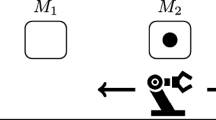Abstract
Consider an m-machine production line for processing identical parts served by a mobile robot. The problem is to find the minimum cycle time for 2-cyclic schedules, that is, schedules in which exactly two parts enter and two parts leave the production line during each cycle. This work treats a special case of the 2-cyclic robot scheduling problem when the robot route is given and operation durations are chosen from prescribed intervals. A strongly polynomial algorithm of time complexity O(m 8log m) is proposed.
Similar content being viewed by others
Explore related subjects
Discover the latest articles, news and stories from top researchers in related subjects.References
Blazewicz, J., Sethi, S. P., & Sriskandarajah, C. (1989). Scheduling of robot moves and parts in a robotic cell. In K. E. Stecke & R. Suri (Eds.), Operations research models and applications (pp. 281–286). Amsterdam: Elsevier.
Brauner, N. (2008). Identical part production in cyclic robotic cells: Concepts, overview and open questions. Discrete Applied Mathematics, 156, 2480–2492.
Brauner, N., & Finke, G. (2001a). Cycles and permutations in robotic cells. Mathematical and Computer Modeling, 34, 565–591.
Brauner, N., & Finke, G. (2001b). Optimal moves of the material handling system in a robotic cell. International Journal of Production Economics, 74, 269–277.
Brauner, N., Finke, G., & Kubiak, W. (2003). Complexity of one-cycle robotic flow shops. Journal of Scheduling, 6(4), 355–371.
Chandru, V., & Rao, M. R. (1999). Linear programming. In M. J. Atallah (Ed.), Algorithms and theory of computation handbook (pp. 31-1–31.37). New York: CRC Press.
Che, A., Chu, C., & Chu, F. (2002). Multicyclic hoist scheduling with constant processing times. IEEE Transactions on Robotics and Automation, 18(1), 69–80.
Che, A., Chu, C., & Levner, E. (2003). A polynomial algorithm for 2-degree cyclic robot scheduling. European Journal of Operational Research, 145(1), 31–44.
Chu, C. (2006). A faster polynomial algorithm for 2-cyclic robotic scheduling. Journal of Scheduling, 9(5), 453–468.
Crama, Y., Kats, V., Van de Klundert, J., & Levner, E. (2000). Cyclic scheduling in robotic flowshop. Annals of Operations Research, 96(1–4), 97–123.
Dawande, M., Sriskandarajah, C., & Sethi, S. P. (2002). On throughput maximization in constant travel time robotic cells. Manufacturing and Service Operations Management, 4(4), 296–312.
Dawande, M., Geismar, H. N., Sethi, S. P., & Sriskandarajah, C. (2005). Sequencing and scheduling in robotic cells: Recent developments. Journal of Scheduling, 8, 387–426.
Dawande, M. W., Geismar, H. N., Sethi, S. P., & Sriskandarajah, C. (2007). Througput optimization in robotic cells. Berlin: Springer.
Dawande, M. W., Geismar, H. N., Pinedo, M., & Sriskandarajah, C. (2010). Throughput optimization in dual-gripper interval robotic cells. IIE Transactions, 42(1), 1–15.
Geismar, H. N., Dawande, M., & Sriskandarajah, C. (2005). Approximation algorithms for k-unit cyclic solutions in robotic cells. European Journal of Operational Research, 162(2), 291–309.
Hall, N. G. (2007). Operations research techniques for robotic systems. In S. Y. Nof (Ed.), Handbook of industrial robotics (Vol. II, pp. 543–577). New York: Wiley.
Ioachim, I., & Soumis, F. (1995). Schedule efficiency in a robotic production cell. International Journal of Flexible Manufacturing Systems, 7, 5–26.
Kats, V., & Levner, E. (2002). Cyclic scheduling on a robotic production line. Journal of Scheduling, 5, 23–41.
Kats, V., & Levner, E. (2008). Parametric algorithms for cyclic scheduling problems with applications to robotics. In A. Gelbukh & E. F. Morales (Eds.), Lecture notes in computer science : Vol. 5317. Proceedings of MICAI-2008 (pp. 653–663). Berlin: Springer.
Kats, V., & Levner, E. (2009). A polynomial algorithm for 2-cyclic robotic scheduling: A non-Euclidean case. Discrete Applied Mathematics, 157(2), 339–355.
Kats, V., Levner, E., & Meyzin, L. (1999). Multiple-part cyclic hoist scheduling using a sieve method. IEEE Transactions on Robotics and Automation, 15(4), 704–713.
Kats, V., Lei, L., & Levner, E. (2008). Minimizing the cycle time of multiple-product processing networks with a fixed operation sequence and time-window constraints. European Journal of Operational Research, 187(3), 1196–1211.
Lei, L., & Wang, T. J. (1989). A proof: the cyclic hoist-scheduling problem is NP-complete (Working paper #89-0016). Graduate School of Management, Rutgers University, New Jersey.
Lei, L., & Wang, T. J. (1994). Determining optimal cyclic hoist schedules in a single-hoist electroplating line. IEE Transactions, 26(2), 25–33.
Levner, E., & Kats, V. (1998). A parametric critical path problem and an application for cyclic scheduling. Discrete Applied Mathematics, 87, 149–158.
Levner, E., Kats, V., & Sriskandarajah, C. (1996). A geometric algorithm for finding two-unit cyclic schedules in no-wait robotic flowshop. In E. Levner (Ed.), Intelligent scheduling of robots and FMS (pp. 101–112). Holon: HAIT Press.
Levner, E., Kats, V., & Levit, V. (1997). An improved algorithm for cyclic flowshop scheduling in a robotic cell. European Journal of Operational Research, 97, 500–508.
Mount, D. M. (2004). Geometric intersection. In J. E. Goodman & J. O’Rourke (Eds.), The handbook of discrete and computational geometry (pp. 857–876). Boca Raton: Chapman&Hall/CRC.
Smale, S. (2000). Mathematical problems for the next century. In V. Arnold, M. Atiyah, P. Lax, & B. Mazur (Eds.), Mathematics: frontiers and perspectives (pp. 271–294). Providence: American Mathematics Society.
Author information
Authors and Affiliations
Corresponding author
Rights and permissions
About this article
Cite this article
Kats, V., Levner, E. Parametric algorithms for 2-cyclic robot scheduling with interval processing times. J Sched 14, 267–279 (2011). https://doi.org/10.1007/s10951-010-0166-0
Published:
Issue Date:
DOI: https://doi.org/10.1007/s10951-010-0166-0




